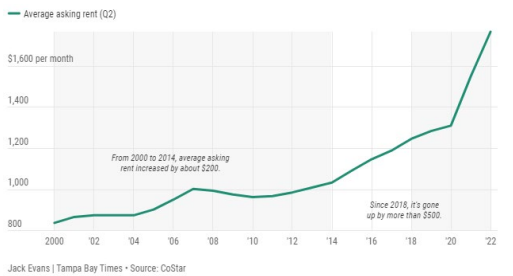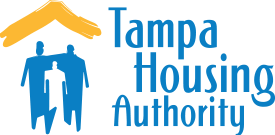How Renting in Tampa Bay Went from Cheap to Expensive, in 11 Charts
Florida's reputation as "the paradise of earth" for the working and middle classes doesn't apply anymore.
Jack Evans, Times staff | Published Oct. 14, 2022

The for rent sign in front of a home on the corner of 3rd Street N and 8th Avenue N on Thursday, Feb. 10, 2022 in St. Petersburg. [ DIRK SHADD ' Times ]
So long as they've been peddling swampland to northerners, Florida has sold itself on the promise of cheap living.
"To the wealthy planter, Florida is eminently inviting," a delegate for a pre-statehood Florida wrote to a Washington, D.C., newspaper in the early 1840s, as the government attempted to draw new residents with free land. "But to the poor and the moderate in circumstance, it is, beyond comparison, the paradise of earth."
Ever since, Florida's reputation as the everyman's Eden has defined it: Come for Mickey. Stay for the endless sunsets.
Florida symbolized the dream of an affordable America, a place where you could retire comfortably on a teacher's pension. Or if you were still working, you might not get rich in one of the abundant service jobs, but you could still afford that cute little apartment with a balcony.
Not anymore.
Across America, the price of everything has shot up over the past few years. And in Florida, rent, the biggest bill for most, has shot up even more.
It was already moving in that direction around Tampa Bay in the past decade. In the last two years, it has skyrocketed, consuming an ever-expanding share of expenses for those on fixed incomes and or in lower-wage jobs.
The numbers tell the story.

Rent in Tampa Bay went up gradually - and then quickly.
The increase in average asking rent across the metro area from 2014 to 2022 was more than triple the increase from the 14 years prior.
What happened to rent?
More than 20 years ago, the promise of an affordable paradise grabbed LaFaye Bodden and pulled her in. A New York City paralegal, she had come to Temple Terrace to visit a friend.
"I was sick of the cold," she said. "I came here one week, and I said, this is it."
She went back to New York and spent the week on the phone, interviewing for jobs. She knew she'd take a pay cut by moving, but soon she was in a 3-bedroom apartment she could easily afford.
Bodden moved into her current apartment, in Temple Terrace, in 2010, paying about $850 for two beds and two baths. Before the pandemic, it went up to about $950. Then $1,135, and $1,335. Recently she got notice that if she wants to stay, she'll have to pay $1,600 a month, plus fees and the water bill.
Her experience is not unusual.
It's not that rental rates in Tampa Bay were totally stagnant before the recent spike. Based on statistics going back to 2000 from the real estate data tracking firm CoStar, there were steady increases in rent across the region for most of the early part of this century. That included a bump coinciding with the housing bubble's inflation in the mid-2000s and a decrease following the subsequent crash. Only in the past decade did average rents consistently surpass $1,000.
But one sign of Tampa Bay's changing costs began around 2014, when rent increases started outpacing inflation.
Even then, Tampa Bay maintained its reputation for affordability. From 2000 to 2017, the average rent here was consistently between $125 and $150 cheaper than the national average. Even amid the housing crash, it was still about $100 cheaper to rent here than the national average.
Starting around 2014, though, the gap between average local rent and average national rent began to close. And in the spring of 2021, the average asking rent in Tampa Bay surpassed the national average for the first time.
"Fair market," higher wages
A longer view of how rents have changed over time - and how substantial that change has been in the past decade - comes via fair-market rent. The U.S. Department of Housing and Urban Development sets that rate every year for units of different size in metro areas across the country. It's typically set at a rate a little cheaper than the area's median rent.
Local housing authorities use those rates to determine how much money they'll contribute toward Section 8 Housing Choice Voucher recipients' rent payments.
Fair market rents fluctuate by ZIP code within the Tampa Bay region. But the Department of Housing and Urban Development also announces metro-level fair-market rents, which we'll use here to get a view of Tampa Bay as a whole.

It used to be cheap to rent in Tampa Bay. Not anymore.
Once consistently less expensive than the national average for asking rent, the advantage for Tampa Bay renters began to narrow around the middle of the last decade, then disappeared in 2021.
It's also worth noting that not everyone who qualifies for Section 8 assistance is getting it: Last year, the Tampa Housing Authority opened applications for a lottery that would allow 3,000 households to get on the waiting list for vouchers. In the one week that it accepted applications, 18,000 people applied.
You may have heard that a household shouldn't spend more than 30% of its pre-tax income on rent, a rule of thumb derived from Section 8 standards. Whether that suggestion applies to you depends on many factors - where you live, what you do, how much debt you have. Still, the Department of Housing and Urban Development has long used 30% as the threshold for whether a household is rent-burdened, or paying more in rent than it can afford and still pay for other necessities, like food and transportation.
Here's the hourly wage a single earner in Tampa Bay would need to make, in a 40-hour week, to spend 30% of their income on a unit at the fair-market rate.
A year ago, keeping Tampa livable for renters was at the top of Garrett Camfferman's mind. He helped launch the Tampa Tenants Union amid an effort to organize his neighbors to lobby for renovations and better communication with their landlords.
Camfferman, 22, worked a series of low-wage jobs: one at a local smoothie shop, another at Amazon's fulfillment center in Ruskin, 45 minutes from his apartment, and eventually a $12-an-hour substitute teaching gig. When his lease was up in early 2022, he said, he and his roommate faced a rent hike they couldn't afford. Camfferman moved back in with his parents in Pinellas County.
"I would've loved to continue living in Tampa, because I love the city, and I loved many people, my neighbors especially," he said. "It just wasn't feasible to continue living there. I had to beg my parents for money on multiple occasions just to pay rent."
Earlier this year, Camfferman realized he couldn't live with his parents forever, and he couldn't afford anything in the Tampa Bay area. Now he lives in Carrboro, North Carolina. He hopes to start taking classes at nearby North Carolina State University early next year. In the meantime, his job at Starbucks is enough to cover the rent.
Minimum wage and Social Security
Section 8 vouchers and other affordable-housing programs aside, rental costs have been burdensome for Tampa Bay's lowest-wage earners for a long time. But over the past four decades, the number of hours a minimum-wage employee would need to work in a week to afford a fair-market unit has increased substantially. That's true despite increases in Florida's minimum wage, including voters' approval of a 2020 amendment that will set minimum wage at $15 by 2026.
For older residents who rely on Social Security income, rental rates were high even in the 1980s. Now, though, a single person's monthly Social Security check won't even cover a studio apartment at Tampa Bay's 2022 fair-market rent, and the picture isn't much better for couples.
Who bears the burden?
Who's most at risk as rents continue to climb? Census data offer a couple of suggestions. The relationship between average rent and median household income by race and gender remained steady during the 2010s. The main takeaway, though, is that rent costs are most burdensome on Black residents - who are more likely to rent, rather than own their homes, compared to households of other races - and on single, childless women, especially those who live alone.
Whatever comes next, it seems unlikely that rents will stop increasing anytime soon. CoStar estimated that by the second quarter of 2023, average rent for the region will be $1,863. At about 5% more than 2022′s second-quarter average rent, that would be a much smaller increase than we've seen over the past couple of years. The latter half of 2021, for example, showed year-over-year increases approaching 25%. Still, it's nearly $100 more than landlords were asking for this past June.
In early September, the federal government released its Fair Market Rents for 2023. The Tampa Bay-wide fair-market rate for a studio apartment was set at $1,291 - just $56 short of the rate set for a 2-bedroom just a year earlier. One-bedrooms were up to $1,381, 2-beds to $1,659. In dollars, the region's Fair Market Rent increase was its biggest ever.
Bodden, the paralegal enticed long ago by Tampa Bay's space and sunshine, says she still hasn't decided whether she'll stay and spend more on rent, or whether she'll see if she can find what Florida once offered somewhere else. But it has become clear to her, she said, that the next generations of renters won't see our region in the same light she did.
"Florida will be out of reach to them," she said. "It won't be the place where you can go and have this nice life and security and not worry about the cost of living."
Talking about what the past few years have brought, she sounded melancholy.
"It was just so sudden."



